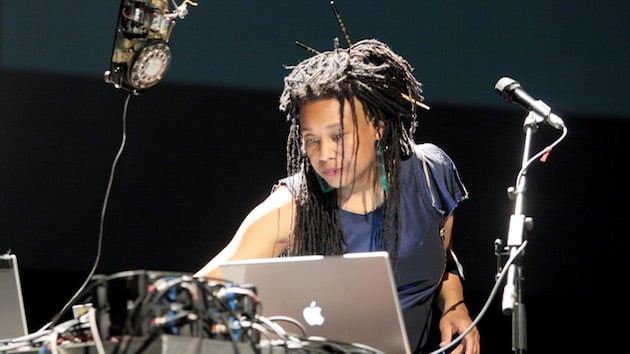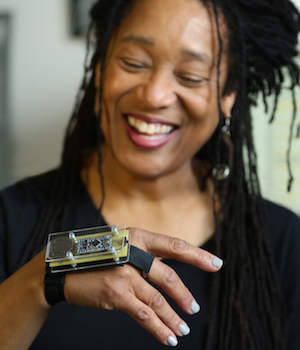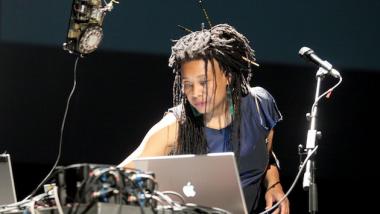
Don't be fooled by Pamela Z.
“The way I work, sadly, is that I’m not done with a piece until the eleventh hour,” the composer, performer, and media artist Pamela Z confides in an interview in advance of her performance at the upcoming New Frequencies Fest.
Creating installation works that blend voice, electronically processed recordings, and video material, Z’s dramatic performances include the use of a gesture-activated, custom-designed MIDI (Musical Instrument Digital Interface) controller. The MIDI transforms her movements into melody, layers her gestures in harmonic, overlapping loops, and more. The effect is mesmerizing, hypnotic enough to lull audiences into forgetting there’s stiff, cutting-edge technology and months of preparation at play.
To analyze Z’s work accurately, a person must also ignore sounds that seem to arise organically as if from nature, instead of from extensive classical training and decades of practice and refinement. Her octave-defying singing carries the purity of a dolphin’s cry. Spoken text vowels and consonants rumble like jostling river rocks. Whispered words and breath mirror the sounds of molecules shifting, either swiftly, as in the onset of wildfire, or gently, like when a newborn infant inhales before uttering it’s first sound. Z’s sonic output is like a cloud: we don’t question its presence in the sky, but imagine all manner of imagery within its outlines.
And placed within the sensational spectrum of the sixth installment of New Frequencies Fest, the Yerba Buena Center for the Arts’ annual plunge into eclectic and contemporary music, it’s possible to believe Z’s work is off-the-cuff, I’ll-just-go-in-there-and-wing-it material.
Instead, even a phone interview from Virginia Tech University, where Z is midstream in a one-week residency, is high strategy.
“I only had two bars inside, so I’m outside and arranging the wind so it doesn’t blow directly into my phone,” she says, as if positioning the weather is within her domain.
Of course, she’s actually scrunching herself against a wall and shifting backpacks and other paraphernalia, but the image remains. After all, among her numerous achievements are performances in a range of venues including Theater Artaud and ODC in San Francisco, the Kitchen, Bang on a Can and the Whitney Museum in New York, at Pina Bausch Tanztheater Festival in Wuppertal, Germany, and more. The work has earned her commissions for dance, film, theater and new music chamber ensembles and awards including, among others, a Guggenheim Fellowship, the Creative Capital Fund, the CalArts Herb Alpert Award, the MAP Fund, and the ASCAP Award.
It’s almost believable that Z’s shape-shifting command might include controlling the forces of nature.
But happily, an impression that could be intimidating becomes warmly human as Z speaks of memories, the subject for Memory Trace, the large-scale solo work she will perform at YBCA.

“When I was a kid, I was interested in music as a sound. We’d take walks and I’d find pods that fell off trees. I remember you’d shake them and they were like maracas. I also strung rubber bands between knobs on my dresser and plucked them for the sound,” she recalls. Z’s instinctive instrument making, her parent’s Israeli folk-dance music, Z and her sister’s British Invasion rock, her mother’s love for crooners like Tony Bennett and Andy Williams and always, classical music, created a varied landscape for listening. “My mother always had a canary too,” she adds. “She’d take the cover off the cage and they’d do a concert every morning. He’d trill, my mother would sing — her voice was high-pitched, tremendously memorable. When she’d answer the phone, even as an adult, people would assume she was a child and ask to speak to her mother.”
Memory Trace springs from Z’s curiosity about human and computer memory, and how they differ and share certain characteristics. She performed the work-in-progress in 2015 at Royce Gallery. Although her mother’s loss of memory was a catalyst for the project, and her mother’s death just days after those performances lingers in her remembrances like much-loved perfume, Z says the work isn’t anchored by being overly literal to her experience. “It’s broader; instead of focused and deep, it’s wide.”
Or vast, as the project’s sweep includes dreams, clips drawn from audio and video interviews with artist associates, photographs of a cuckoo clock she became fascinated by, videos of her trip to Senegal and of Z, wandering in the woods. Playing with fragments of speech, clustering sounds according to principles of music composition more than narrative content, the work divides into approximately 15 sections, each one lasting only 3–7 minutes.
Z is particularly pleased by overlapping answers people gave to interview questions. “I love it that there’s always one or two questions I ask that people say the same words. I make a chorus out of their voices, with people who’ve never been in the same room together speaking in unison.” Despite her effort to divorce herself from the meaning of words, Z says there is “meaningness coded” into language. “You can’t easily shed that, but if you repeat a phrase or word over and over again, it tends to lose that and takes on other meanings.”
Expectedly, movement is allowed the same flexibility. Facial features that are common to people struggling to recall a memory, or gestures that people rarely if ever make but that are nevertheless associated with remembering — like tapping a temple with a forefinger — enter the work’s abstract frame and repeat in videos and still images. One section, with Z wandering and lost amid trees, multiplies into many Z’s searching in the wilderness. “What is that about? I’m not sure yet, but I don’t go out of my way to encode that. People will look and have different accounts. It’s like witness accounts, where you ask five people to tell you what happened and there’s five different accounts. The differing and changing memories is interesting.”
Still contemplating how she will handle the interactive elements of Memory Trace, Z lays the groundwork for more 11th-hour solutions. Aspects that worked well in the Royce’s intimate space — a scented section, a moment when an audience member handed a phone responds to an actual caller — are a challenge in a larger venue. “It looks like I’ll be figuring that out just beforehand,” she says. “In a way, I never feel a piece is complete until the live performance.”
The three-day New Frequencies Fest also features artists Edward Schocker, Theresa Wong, and Luciano Chessa.

